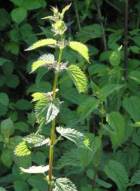
In the gloom of a rainy, early spring day, I point out to my companion how to identify(1) stinging nettles (Urtica dioica). I tell her to look for places with rich, moist soil, for nettles prefer these sites, growing in sun or shade.
Nettles superficially resemble mints, with square stems and opposite leaves. The leaf blade is oval to heart-shaped, with scalloped edges. The hollow, needlelike hairs on stem and leaves are their defining feature, filled with formic acid and other irritating chemicals. When touched, the sharp tip breaks off, injecting the irritants into the skin.
The plant has thus armed itself to deter browsing animals, as nettles are tasty and very nutritious. I kneel on the mossy ground, rain dripping off my hood as I snip off the upper half of the stem and leaves, and put it in the bag with my gloved hands. The plants are about 6 inches tall now, later they will grow to 3 feet or more. As the base of the stem and lower leaves are left behind, it will form new shoots and recover. Gathering the new, young leaves is preferred, as both the leaves and stem become more fibrous as the plant matures.
Found throughout the U.S., Canada, and much of Europe and Asia, nettles have long been prized as an early source of greens, and used medicinally for various ailments. Rhizamatous perennials, they can be grown in a garden setting as well as collected from the wild.(2) Stinging nettles are high in protein, iron, vitamins A, C, and K, and other nutrients. Their taste is similar to that of spinach. Nettles are anti-inflammatory, and have often been used to soothe allergic reactions.
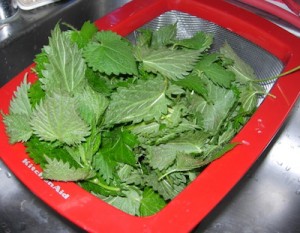 Within an hour our bags are full, and we walk out of the forest and join friends around their wood stove to warm up with good conversation and coffee. Once home I spread some of the nettles out on cookie sheets to dry, so I can make nettle tea when my allergies flare up. Later in the day I gather the ingredients for making nettle soup.
Within an hour our bags are full, and we walk out of the forest and join friends around their wood stove to warm up with good conversation and coffee. Once home I spread some of the nettles out on cookie sheets to dry, so I can make nettle tea when my allergies flare up. Later in the day I gather the ingredients for making nettle soup.
First I wash the nettles, then blanch them briefly, finally pureeing them in a food processor and set aside. Then I heat a little olive oil in a large pot, and add chopped onion and garlic. When the onion is limp, I add chicken stock and cubed potatoes. After the potatoes are soft, I mash them just a bit to make the soup thick and chunky. At last I add the nettles and a little salt and pepper, cooking the mixture for a few more minutes to blend the flavors.
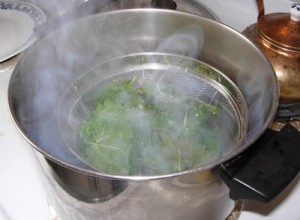 As I sit down to my steaming bowl of soup, I feel close to the earth and content, following in the footsteps of so many before me. The soup has a definite peppery bite this year. I taste the blend of potato and greens, along with a few top notes of the mossy forest from whence the nettles came. Afterwards I reflect for a moment on the simple pleasures life offers. I head out the door smiling, ready to face the modern world, fortified with a dose of nature’s bounty.
As I sit down to my steaming bowl of soup, I feel close to the earth and content, following in the footsteps of so many before me. The soup has a definite peppery bite this year. I taste the blend of potato and greens, along with a few top notes of the mossy forest from whence the nettles came. Afterwards I reflect for a moment on the simple pleasures life offers. I head out the door smiling, ready to face the modern world, fortified with a dose of nature’s bounty.
(1) When in doubt, always check your ID with an expert or plant key.
(2) Always be considerate when collecting, get the landowner’s permission before gathering wild plants, and do not collect near public trails or roads.
Nettle Soup
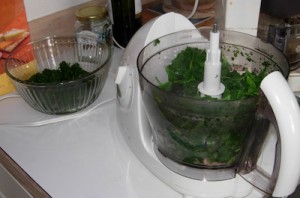 There are many versions of this soup, I use the one below. Feel free (I do) to change the amount of potatoes or nettles to alter the balance of flavors to your liking.
There are many versions of this soup, I use the one below. Feel free (I do) to change the amount of potatoes or nettles to alter the balance of flavors to your liking.
1 onion, peeled and chopped
4 cloves garlic, minced
2 tablespoons olive oil
8 cups chicken (or vegetable) broth
6-8 potatoes, peeled and cubed
8-10 cups of packed nettle leaves and stem tops
salt and pepper
Wash, blanch, and puree nettles, set aside. In a large heavy soup pot, heat the olive oil, add chopped onion. 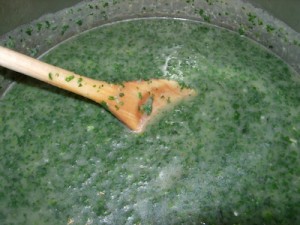 When onion is limp, add garlic, sauté for a couple minutes more. Then add chicken broth and cubed potatoes. Simmer for about 20 minutes or until potatoes are soft. Mash with spoon or potato masher for a chunky soup, or puree for a smooth soup. Add pureed nettles, cook just long enough to heat through. Add salt and pepper to taste.
When onion is limp, add garlic, sauté for a couple minutes more. Then add chicken broth and cubed potatoes. Simmer for about 20 minutes or until potatoes are soft. Mash with spoon or potato masher for a chunky soup, or puree for a smooth soup. Add pureed nettles, cook just long enough to heat through. Add salt and pepper to taste.
About Ellen Kuhlmann
Ellen Kuhlmann received a M.S. in Biology with an emphasis in plant ecology from Western Washington University in 1994. She worked for the U.S. Forest Service as a field and research botanist for over 15 years. For the past 5 years, Ellen has been the Seeds of Success Program Manager for Rare Plant Care and Conservation, a Seattle-based nonprofit. Seeds of Success collects wild plant seed for the Kew Millennium Seed Bank run by the Royal Botanic Gardens, Kew of the U.K., and for the U.S. National Native Plant Materials Program.
Photos: Ellen Kuhlmann
